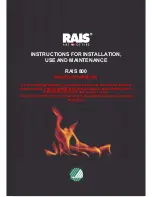
~
12 ~
1.
Check your flue system for build up of soot or creosote and for signs of damage to
joints. To check flue outlet remove top of baffle by lifting and pulling out at end. Use
a flashlight to check flue outlet. Clean and repair as necessary. Always replace top
baffle before relighting stove.
2.
Check that glass is not cracked or chipped and that sealing rope is in good condition.
Replace as necessary.
3.
When the room is dark, use a strong flashlight to check the sealing of the stove at
the edge and corners for leaks. Any leaks or cracks found should be repaired with fire
cement or damaged parts should be replaced with genuine spare parts.
4.
Check that stove door is tight and well sealed when closed. Place a strip of paper into
the stove and close the door, try to pull out paper. You should feel some resistance
to your pull, check several points around the door. If it pulls out too easily, replace
the rope and seal in place with a suitable high temperature sealant.
Replacing parts
Always use genuine replacement parts. Only ever make replacements when the stove is
cold.
Surface finish
The stove should only be cleaned using a damp cloth. Some cleaning products may leave
stains on the stove surface. Never use abrasive cloths as these may scratch the surface.
Painted stoves can be re-painted by using a good quality, high temperature stove paint.
When re-painting, make sure there is plenty of ventilation and follow the manufacturer’s
instructions. Allow the paint to fully dry before lighting the stove and allow extra ventila-
tion for the first couple of fires as some fumes may emit from the stove as the paint cures.
Wetback (Boiler)
Check the surface of your boiler regularly, if you find a build-up of creosote scrap away
with a flat steel scraper. This build-up of creosote will insulate the boiler and reduce the
heat absorbed by the water.
Trouble Shooting
Fire not burning
A stove not burning is generally caused by either a shortage of air and/or incorrect or
damp fuel. If fuel is not the problem check:
That the air controls are opened.
There is no blockage in the flue system.
That the open end of the flue is above the height of any nearby obstructions.
That there is a sufficient air supply into the room and that this supply is not being
taken by an extractor fan.



































